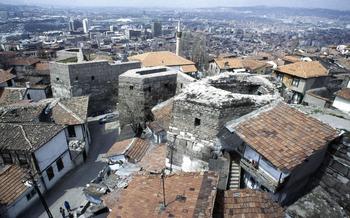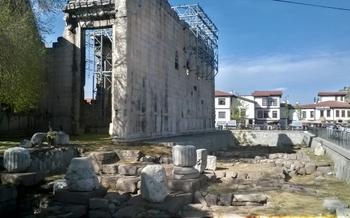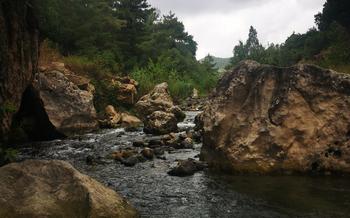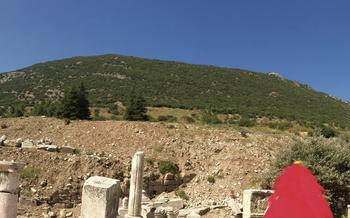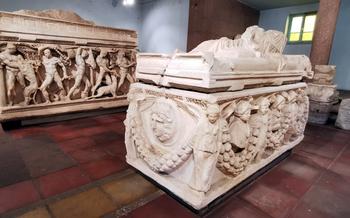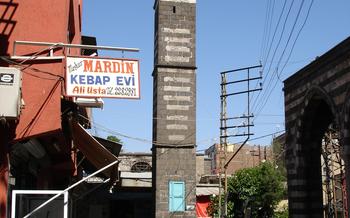
Column of Julian
- The Column of Julian: A Monumental Legacy in Ankara
- Unveiling the History of the Column
- Exploring the Architectural Masterpiece
- Location and Accessibility: Finding the Column
- Preservation and Conservation Efforts
- A Walk Through History: Exploring the Surrounding Area
- Julian the Apostate: The Man Behind the Column
- Unraveling the Ancient Inscriptions
- The Column's Role in Modern Ankara
- Capturing the Perfect Shot: Photography Tips
- Visiting Hours and Admission Fees
- Nearby Restaurants and Cafes for a Culinary Break
- Souvenirs and Mementos: Preserving the Memory
- Insider Tip:
- Events and Festivals: Celebrating History and Culture
- Insider Tip: Uncovering Hidden Details
The Column of Julian: A Monumental Legacy in Ankara
In the heart of modern Ankara, Turkey, stands a remarkable testament to ancient Roman history and engineering prowess: the Column of Julian. Erected in the 4th century AD during the reign of Emperor Julian, this grand column has stood tall for centuries, witnessing the rise and fall of civilizations and the ever-changing landscape of the city. With its intricate carvings, towering height, and historical significance, the Column of Julian remains a captivating landmark that draws visitors from around the world.
Located in the Ulus district, near Ankara Castle, the column stands as a solitary sentinel, surrounded by modern buildings and bustling streets. Despite its age, the column is remarkably well-preserved, thanks to ongoing restoration efforts and the dedication of local authorities. The column's impressive height and intricate carvings make it a sight to behold, inviting visitors to explore its history and marvel at the architectural mastery of the ancient Romans.
The Column of Julian is not just a historical artifact but also a symbol of Ankara's rich cultural heritage. Its enduring presence serves as a reminder of the city's ancient roots and its significance as a crossroads of civilizations. Whether you're a history buff, an architecture enthusiast, or simply a curious traveler, the Column of Julian is a must-visit destination that offers a glimpse into Ankara's glorious past.
Unveiling the History of the Column
The Column of Julian stands as a testament to the reign of Emperor Julian, who ruled the Roman Empire from 361 to 363 AD. A staunch supporter of Hellenism, Julian sought to revive the ancient Roman traditions and religious practices that had been gradually replaced by Christianity. His decision to erect this column in Ankara, the ancient city of Ancyra, was a symbolic gesture of his commitment to restoring the old ways.
The column served multiple purposes. It commemorated Julian's victory over the Persians in 363 AD, providing a physical manifestation of his military prowess and the glory of the Roman Empire. It also served as a monument to the gods of the Roman pantheon, whom Julian fervently worshipped. The intricate carvings on the column's capital depict scenes from Greek mythology, further emphasizing Julian's devotion to the old religion.
Beyond its symbolic and commemorative significance, the Column of Julian offers valuable insights into ancient Roman engineering and architecture. Its height, diameter, and construction materials demonstrate the remarkable engineering skills of the Roman builders. The column's Corinthian capital, with its intricate carvings and lifelike figures, showcases the artistic prowess and attention to detail that characterized Roman architecture.
The column also serves as a reminder of the religious conflicts that plagued the Roman Empire during the 4th century AD. Julian's attempt to revive paganism met with fierce resistance from the Christian community, leading to widespread persecution and conflict. The Battle of Samarra in 363 AD, in which Julian was killed, marked the end of his reign and the ultimate triumph of Christianity within the Roman Empire.
Exploring the Architectural Masterpiece
The Column of Julian stands tall as an architectural masterpiece, showcasing the ingenuity and craftsmanship of ancient Roman engineers. Its unique Corinthian capital, intricately carved with acanthus leaves and volutes, is a testament to the artistic prowess of the era. The column's height, estimated to be around 15 meters, and its impressive diameter, measuring approximately 2 meters, add to its grandeur. Constructed using locally sourced limestone, the column's resilience and longevity are a testament to the quality of materials and construction techniques employed by the Romans.
Comparisons with other ancient columns and monuments reveal the Column of Julian's significance. While it may not rival the height of Trajan's Column in Rome or the intricacy of the Luxor Obelisk in Paris, it holds its own as a unique and well-preserved example of Roman architecture. Its Corinthian capital, with its distinctive acanthus leaf motifs, sets it apart from other columns, showcasing the diversity of styles and influences within Roman architecture.
The Column of Julian's architectural significance extends beyond its individual features. It serves as a reminder of the Roman Empire's influence and legacy in the region. Its presence in Ankara, the modern-day capital of Turkey, speaks to the enduring impact of Roman rule and the continuity of historical heritage across centuries. The column's architectural design and construction techniques have influenced later structures and architectural styles, demonstrating its ongoing relevance and inspiration in the field of architecture.
Location and Accessibility: Finding the Column
The Column of Julian stands proudly in the heart of Ankara, Turkey, at Julianus Sütunu Parkı, a small park dedicated to preserving the monument's historical significance. It is situated in the Ulus district, known for its historical landmarks and vibrant atmosphere.
To reach the column, visitors can take advantage of Ankara's well-connected public transportation system. The Ulus stop on the Ankaray light rail line is just a short walk from the park. Alternatively, several bus lines, including the 306-3, 309-5, and 339-2, stop nearby.
For those arriving by car, limited street parking is available in the vicinity. However, it is advisable to plan accordingly, as the area can be busy during peak tourist season.
Once at the site, visitors will find the column surrounded by a well-maintained garden, providing a tranquil oasis amidst the urban bustle. Benches and shaded areas invite visitors to linger and soak in the historical atmosphere.
Whether exploring Ankara's rich history or simply admiring the architectural grandeur of the Column of Julian, the monument's convenient location and accessibility make it a must-visit destination for anyone interested in ancient Roman history and culture.
Preservation and Conservation Efforts
The Column of Julian, standing tall in the heart of Ankara, has faced the test of time and various environmental factors. Preserving this ancient monument requires ongoing efforts to maintain its integrity and ensure its longevity. Recognizing the significance of this historical treasure, authorities, archaeologists, and conservationists have collaborated on various projects to protect and restore the column.
One of the primary challenges in preserving the Column of Julian lies in its exposure to weathering and pollution. The natural wear and tear caused by wind, rain, and air pollution can gradually erode the stone's surface and damage its intricate carvings. To address this, regular cleaning and maintenance procedures are carried out to remove dirt and pollutants, preventing further deterioration.
In addition, structural assessments and repairs are conducted periodically to ensure the stability of the column. Engineers and architects carefully examine the monument's foundation, joints, and overall structure, identifying any signs of weakness or damage. Necessary repairs are then carried out using techniques that respect the column's historical integrity and minimize any visual impact.
Furthermore, conservation efforts involve the documentation and study of the column's materials and construction methods. Researchers analyze the stone's composition, examine the carving techniques, and investigate the engineering principles employed in its निर्माण. This knowledge helps in developing informed conservation strategies and selecting appropriate materials for restoration work.
Preserving the Column of Julian is not merely a technical endeavor; it also carries cultural and historical significance. By safeguarding this monument, we preserve a tangible link to our past, allowing future generations to appreciate its architectural beauty and historical importance. The ongoing efforts to protect and restore the column ensure that this iconic landmark continues to stand as a testament to the rich cultural heritage of Ankara and the Roman Empire.
A Walk Through History: Exploring the Surrounding Area
The Column of Julian stands as a proud sentinel amidst a treasure trove of historical landmarks and attractions. Take a leisurely stroll through the surrounding neighborhood to unravel the rich tapestry of Ankara's past. Just a few steps away, you'll find the Ankara Castle, a magnificent fortress that has witnessed centuries of battles and conquests. Explore its imposing walls, towers, and gates to delve into the city's fascinating military history.
Nearby, the Hacı Bayram Mosque stands as a testament to Ankara's spiritual heritage. This 15th-century mosque is not only a place of worship but also a masterpiece of Islamic architecture. Admire its intricate tilework, elegant domes, and serene courtyard, inviting you to immerse yourself in the city's religious traditions.
For those seeking a glimpse into Ankara's vibrant cultural scene, the Çengelhan Rahmi M. Koç Museum is a must-visit. Housed in a restored caravanserai, this museum showcases a diverse collection of artifacts, from vintage cars and motorcycles to antique toys and machinery. It's a fascinating journey through the city's industrial and technological heritage.
To fully appreciate the neighborhood's historical significance, consider embarking on a guided walking tour. These tours, often led by local historians or archaeologists, provide insightful commentary and anecdotes that bring the past to life. They'll point out hidden gems and lesser-known historical treasures that you might otherwise miss.
Whether you wander independently or join a guided tour, exploring the area surrounding the Column of Julian is a captivating experience that weaves together the threads of Ankara's rich history.
Julian the Apostate: The Man Behind the Column
Julian, known as Julian the Apostate by Christian historians due to his rejection of Christianity, was a fascinating and controversial figure in Roman history. Born in 332 AD, he became emperor in 361 AD after the death of his cousin, Constantius II. Julian's reign was marked by his attempts to revive traditional Roman values and restore the prominence of paganism.
He sought to undo the influence of Christianity, which had become the official religion of the empire under Constantine the Great. Julian issued edicts that favored pagans over Christians, and he attempted to restore pagan temples and rituals. His efforts were met with resistance from the Christian community, and tensions escalated, leading to conflicts and the Battle of Samarra in 363 AD, where Julian was killed.
Despite his short reign, Julian's impact on the Roman Empire was significant. His religious policies sparked debates and controversies that shaped the course of Christianity in the empire. Julian's rule also shed light on the challenges of ruling a diverse empire with different religious beliefs and the ongoing tensions between paganism and Christianity.
Unraveling the Ancient Inscriptions
The Column of Julian features several Latin inscriptions that provide valuable insights into the emperor's political and religious beliefs. These inscriptions, etched into the stone centuries ago, offer a glimpse into the mindset and motivations of Julian, a complex and controversial figure in Roman history.
One inscription, located at the base of the column, reads: "To the invincible Sun, Mithras, the protector of the Roman Empire, Julian, the pious and victorious emperor, dedicated this monument." This inscription reveals Julian's devotion to the ancient Persian sun god Mithras, whom he favored over the Christian God.
Another inscription, found on the side of the column, proclaims: "By this sign, the impious Galileans shall be confounded." This inscription refers to the Christian symbol of the cross, which Julian sought to eradicate from the Roman Empire. It reflects his strong opposition to Christianity and his attempts to revive paganism.
These inscriptions not only provide historical context but also offer a glimpse into the religious and political struggles that shaped Julian's reign. They serve as a testament to his unwavering commitment to his beliefs and his determination to reshape the religious landscape of the Roman Empire.
The Column's Role in Modern Ankara
The Column of Julian stands as a symbol of Ankara's rich historical heritage and a testament to the city's enduring spirit. Deeply ingrained in the urban fabric, the column has become an integral part of Ankara's identity, serving as a source of pride for its residents and a captivating attraction for visitors from around the world.
The column's presence has influenced urban planning and development, contributing to the creation of public spaces and historic districts that celebrate Ankara's past. Its iconic silhouette serves as a landmark, guiding visitors through the city's bustling streets and inviting them to explore its hidden gems.
Moreover, the column plays a crucial role in promoting cultural heritage and tourism in Ankara. Its historical significance attracts history buffs, archaeologists, and tourists alike, eager to learn about the city's ancient roots and the fascinating stories that unfold within its walls. The column's inclusion in guided tours and itineraries ensures that visitors gain a deeper understanding of Ankara's rich tapestry of civilizations.
Beyond its historical and cultural significance, the Column of Julian fosters a sense of ownership and belonging among the people of Ankara. It is a tangible reminder of the city's resilience and the enduring legacy of its past. The column serves as a symbol of unity, bringing together people from all walks of life to appreciate and celebrate their shared heritage.
Capturing the Perfect Shot: Photography Tips
The Column of Julian presents a captivating subject for photographers, offering a blend of historical significance and architectural grandeur. To capture the column's essence, choose the right angle and perspective. Stand at a distance to capture its full height, or move closer to highlight intricate details. Experiment with different lighting conditions; early morning or late afternoon light casts dramatic shadows, while midday light provides even illumination.
Compose your shot carefully. Include surrounding elements like trees or buildings to add depth and context. Use a wide-angle lens to exaggerate the column's height or a telephoto lens to isolate specific features. Experiment with filters to enhance colors or create a unique mood.
For stunning results, consider using a tripod to stabilize your camera, especially when shooting in low-light conditions. Explore different camera settings to achieve the desired effect. A slow shutter speed can create a sense of movement, while a fast shutter speed freezes the action.
Don't forget to experiment with different perspectives. Try shooting from a low angle to emphasize the column's towering presence or from a high vantage point to capture the surrounding cityscape.
Remember, the best photographs often come from experimentation and creativity. So, take your time, explore different angles and settings, and let your creativity flow.
Visiting Hours and Admission Fees
The Column of Julian is open to the public daily, from 8:30 am to 5:30 pm. Visitors are welcome to explore the site at their leisure and admire the column's grandeur from various angles. Admission to the site is free of charge, allowing everyone the opportunity to experience this historical landmark without any financial barriers. It's worth noting that the column is occasionally closed for maintenance or special events, so it's advisable to check the official website or contact the local tourism office for the most up-to-date information.
Nearby Restaurants and Cafes for a Culinary Break
After exploring the Column of Julian and immersing yourself in its rich history, you may want to take a break and savor the delectable flavors of Turkish cuisine. Fortunately, the area surrounding the column offers a diverse range of dining options that cater to various tastes and preferences.
For a taste of authentic Turkish cuisine, head to one of the traditional restaurants near the column. These establishments serve up mouthwatering dishes such as kebabs, pide, and meze platters. Enjoy the vibrant ambiance and warm hospitality as you indulge in the flavors of Turkish culinary traditions.
If you're looking for a more international dining experience, there are several cafes and restaurants in the area that offer a variety of cuisines from around the world. From Italian pasta to Japanese sushi, you're sure to find something to satisfy your cravings.
Whether you're looking for a quick bite or a leisurely meal, there are plenty of options to choose from near the Column of Julian. Take your time to explore the local culinary scene and discover the hidden gems that await. Vegetarian and vegan options are also available for those with dietary restrictions.
Souvenirs and Mementos: Preserving the Memory
Visiting the Column of Julian is an experience that leaves a lasting impression, and many visitors seek to take home a memento of their time spent there. The surrounding area offers a variety of unique souvenirs and handicrafts inspired by the column's rich history and architectural significance.
From intricate replicas of the column in various sizes to traditional Turkish handicrafts featuring motifs and designs reminiscent of the era, there is something for every taste and budget. Local markets and shops are treasure troves of authentic souvenirs, where visitors can bargain and find the best deals.
For those seeking truly unique items, custom-made souvenirs can be commissioned from local artisans. These personalized mementos, such as jewelry, pottery, or leather goods, are a special way to commemorate a visit to the Column of Julian.
Insider Tip:
Engage with local historians or guides to uncover hidden details and lesser-known stories related to the column. They can provide insights into the significance of the inscriptions, the construction techniques, and the role of the monument in ancient Roman society. This deeper understanding will enhance your appreciation of the Column of Julian and its enduring legacy.
Events and Festivals: Celebrating History and Culture
The Column of Julian stands as a silent witness to the rich history and vibrant culture of Ankara. Throughout the year, the city hosts a variety of events and festivals that celebrate its heritage and bring the past to life. One of the most notable events is the Ankara International Film Festival, held annually in March. This prestigious festival showcases a diverse range of films from around the world, with a special focus on Turkish cinema.
For those interested in history and archaeology, the Ankara Archaeology Festival in May is a must-attend event. This festival features exhibitions, workshops, and lectures by leading experts in the field, providing an opportunity to delve deeper into the ancient past of Ankara and the surrounding region.
If you are visiting during the summer months, be sure to catch the Ankara Music Festival. Held in July and August, this festival features a wide variety of musical performances, from classical to contemporary, in venues across the city. The festival culminates in a grand finale concert at the iconic Column of Julian, creating a truly magical atmosphere.
Insider Tip: Uncovering Hidden Details
To truly immerse yourself in the history of the Column of Julian, seek out the hidden details that often go unnoticed. Explore the surrounding area and discover secret spots that offer unique perspectives of the column, capturing its grandeur from different angles. Delve into lesser-known historical facts and anecdotes related to the site, bringing the past to life. Recommended books, documentaries, or online resources can provide deeper insights into the monument and its significance. Engage with local historians or guides who can share their knowledge and personal stories, offering a deeper understanding of this ancient treasure.

